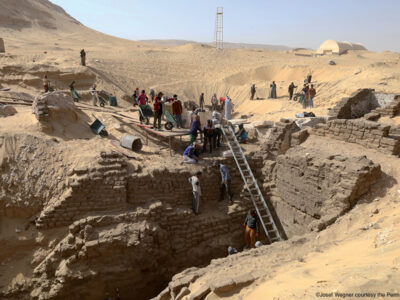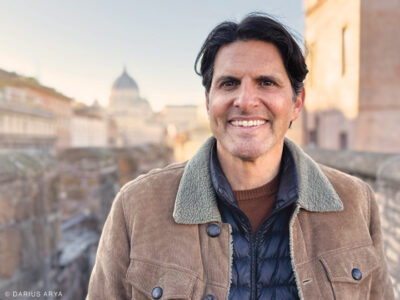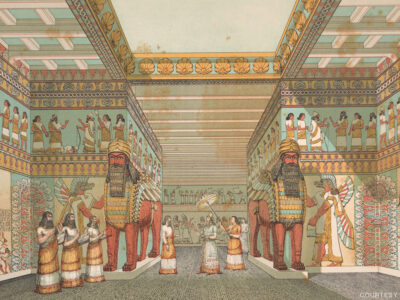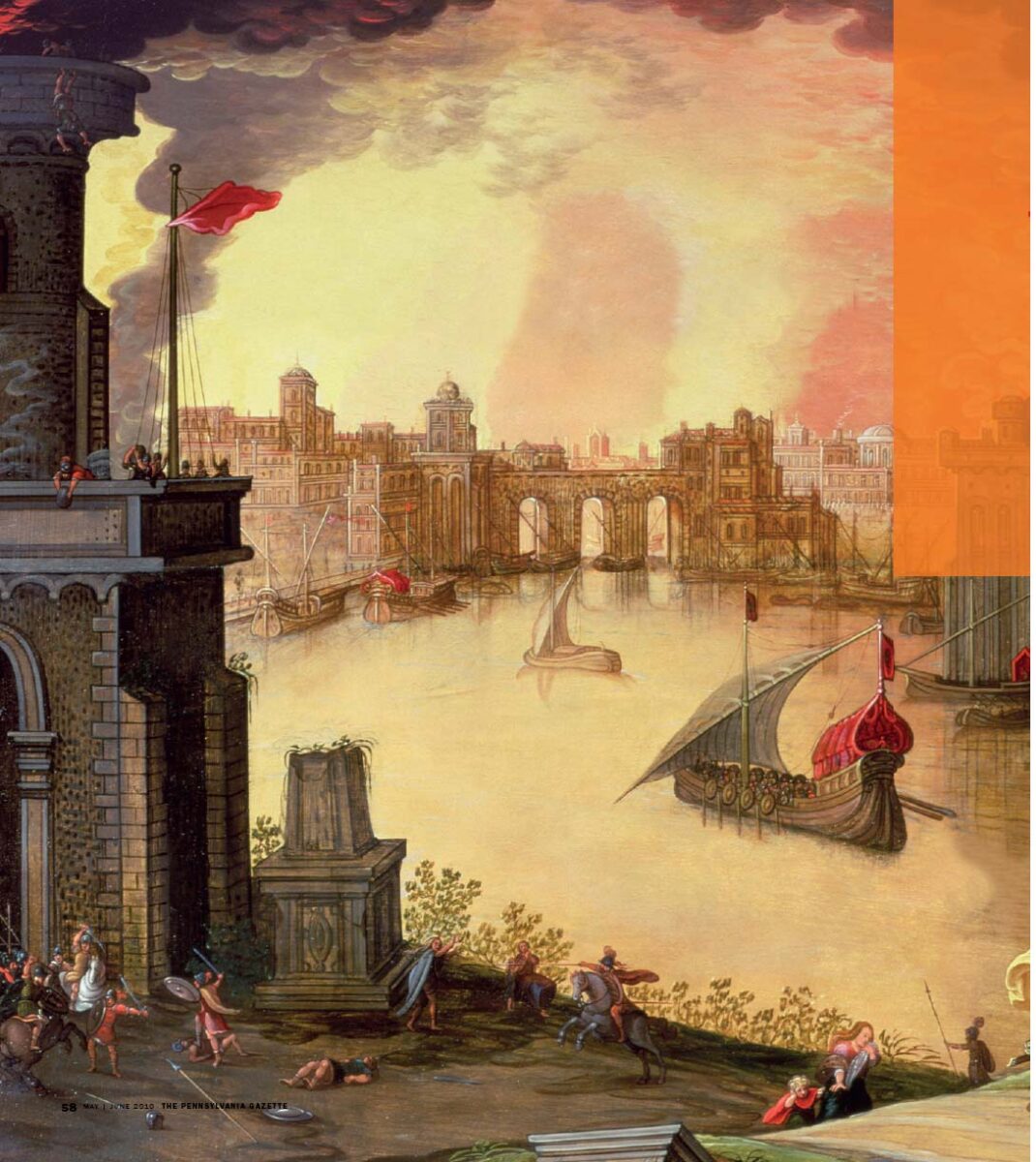
Ever since Heinrich Schliemann “discovered” Troy in the 1870s, archaeologists have searched for proof that Homer’s Iliad was based on historical fact. Penn Museum Deputy Director C. Brian Rose, who has led excavations at the site for more than two decades, may have found it.
by Dennis Drabelle

“We do care about the authenticity of the tale of Troy!” wrote Lord Byron.
“I venerate the grand original as the truth of history … and of place;
otherwise it would have given me no delight.”
Byron was hardly alone in his venerating. Western Civilization itself has a stake in the historicity of the Trojan War. As best we can tell, Homer composed the Iliad and the Odyssey in the late 8th or early 7th century B.C., about events thought to have taken place five centuries previously. The two poems will mean far more to us if we can be confident they had some basis in fact—a fortified city that stood roughly where Homer says it did, and a war fought there (perhaps over a beautiful woman) by “characters” at least some of whom actually lived. Otherwise, our founding epics are reduced to the level of elaborate folk tales, rather like The Thousand and One Nights or Wagner’s Ring Cycle, except with gods and goddesses instead of djinns and Valkyries.
The urge to ground the Trojan story in reality has kept archaeologists busy for well over a century. In the late 19th century, Heinrich Schliemann became world-famous as the discoverer of Troy, and others have devoted their careers to refining and correcting his work. One of the most energetic current practitioners in the field is C. Brian Rose, who heads post-Bronze Age excavations at Troy. At Penn, Rose is the James B. Pritchard Professor of Archaeology and a professor of classical studies in the School of Arts and Sciences, while also serving as deputy director of the Penn Museum.
The eastern Mediterranean had long been a stomping ground for European lovers of the classics and collectors of antiquities. Starting in the 1860s, however, a more focused student emerged from the pack: the German-born Schliemann, son of a Protestant minister and his wife. Schliemann is not the easiest historical figure to get to know. As he admitted, “My biggest fault [was] being a braggart and bluffer,” and some of the stories he told about himself are fictitious. Until someone writes a definitive biography, the following is no more than a reasonably likely account of the first celebrity archaeologist’s formative years.
Although later renowned as a polyglot, the young Schliemann was no whiz at languages—as a schoolboy, he received an “unsatisfactory” in Latin. The family fell on hard times, and he had to transfer from an academic high school to a commercial one. In any case, he dropped out at age 14.
The adult Schliemann gave out at least two versions of his first contact with Homer. In one, as a 10-year-old he heard the splendid tales of gods and heroes from his father and was hooked for life. But a letter from Schliemann to his father, written when the latter was an old man, casts doubt on this transmittal. In it, the son says, in effect, Be prepared: I’ve been going around telling people I caught the Homeric bug from you when I was a kid. The other version is preferable, if only because we have no particular reason to doubt it: while working as a grocer’s apprentice, Schliemann heard a drunken miller recite Homer in the original and fell in love with the sound. “From that moment,” he commented, “I never ceased to pray God that by His grace I might yet have the happiness of learning ancient Greek.”
In the meantime, Latin was the last language Schliemann ever flunked. He rose through the ranks of various European commercial houses for which he worked, thanks in part to his successive mastery of English, French, Dutch, Spanish, Italian, Portuguese, and Russian. (One of his techniques with a new language was to use it exclusively in his journal until fluency came.) By his mid-twenties, he’d gone into business for himself, dealing in such commodities as indigo, tea, coffee, and sugar. Somewhere along the way, the young whirlwind also fulfilled his dream of learning Classical Greek.

One of Schliemann’s brothers had emigrated to California during the Gold Rush and made a pile of money as an innkeeper. When the brother died, Heinrich crossed the ocean to see what he could do with the family’s interests. Arriving in 1851, he started a bank, which earned lavish profits. He made another fortune by speculating in cotton during the Civil War. In 1864, back in Europe and still in his early forties, he was rich enough to retire and do as he liked. What he liked was to abandon his wife and three children for months at a time, take courses at the Sorbonne, travel, and cultivate his antiquarian interests.
The central dynamic of the Schliemann legend is that the site of Troy had been lost and that he made good on an obsession with finding it. “Was it really lost?” Brian Rose asks rhetorically when I raise the point in his office at the Penn Museum. Inhabitants of the region—the vicinity of a hill called Hisarlik, which overlooks the Dardanelles Strait on the northwest coast of Turkey—could see the ruins of a Roman town, built on top of what they believed was ancient Troy. “And we hear of high-profile visits at least through the 15th century,” Rose continues. “One visitor was Mehmet the Conqueror, the Ottoman sultan, who came in 1462, nine years after sacking Constantinople. He stood there and claimed he’d avenged what the Greeks had done to Troy. It’s conceivable that other visitors after Mehmet also identified this as the site of Troy, but no records have survived.” Schliemann’s discovery of Troy, then, may not be all that different from Columbus’s discovery of the New World—to the locals, the news that anything was lost or unknown would have come as a shock.
Schliemann had proceeded by drawing on clues from the Iliad and on the expertise of Frank Calvert, scion of a family that enjoyed a near-monopoly on regional diplomacy. Despite being British, Calvert served as American consul in the area, and he owned some of the property under which he thought Troy was buried. He shared his hunches with Schliemann, who had the money and the drive to undertake the necessary excavations. “Calvert is more deserving [than Schliemann] of the title of Finder of Troy,” says Rose. But Calvert was cash-poor and self-effacing, whereas Schliemann was a free spender with a knack for garnering publicity; it wasn’t long before the upstart had elbowed his mentor into obscurity.
“When Schliemann announced he had found the Treasure of Priam in 1873,” Rose continues, “it made headlines around the world.” The Treasure is a collection of glittering artifacts, including a gold diadem that Schliemann’s second wife modeled for a famous photograph. Schliemann claimed that the haul was associated with King Priam, who ruled Troy during the Trojan War, and that the ruins among which it had been found were Homer’s Troy itself.
To get that far down, Schliemann had dug through a series of cities and citadels, one built atop the ruins of another (the latest count is 10 primary levels), hoping to uncover two things side-by-side: pottery dating from the period of the Trojan War and signs of destruction commensurate with a sacked city; Priam’s Treasure had been an unexpected bonus. Believing that he’d pulled off the coup of a lifetime (and never one for modesty), Schliemann trumpeted his findings in articles, books, photographs, and interviews. By the end of his life, however, he had come to a sobering realization about his results: right site, wrong level. (The Treasure of Priam currently resides in—of all places—Moscow, where it has been since 1945: Schliemann had given it to a German museum, from which it was swiped by Russian soldiers when they occupied Berlin at the end of World War II. Despite all this pillaging, however, Priam can rest in peace: archaeologists now believe the Treasure’s artifacts were made a thousand years before his reign.)
After Schliemann’s death in 1890, his successor, the German archaeologist Wilhelm Dörpfeld, carried on the master’s work, refining, synthesizing, and trying to pin down an excavation level that would jibe with Homeric Troy. In the 1920s and ’30s, directorship of the Troy excavations shifted to the United States, specifically to the University of Cincinnati, under the leadership of the American archaeologist Carl Blegen. That work ceased in 1938, but in 1987 a German archaeologist named Manfred Korfmann sought to revive the dig at Hisarlik. He approached the University of Cincinnati about a partnership.
“Manfred had grown up during World War II,” Rose explains. “He had seen what divisiveness had done to his country, so approaching a U.S. partner was in harmony with his outlook.” Korfmann’s overture resulted in a cooperative program between Cincinnati and his institution, the University of Tübingen, beginning in 1988. And this is where Rose himself comes in.
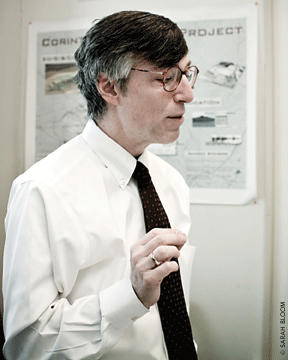
With mere flecks of gray in his mop of brown hair, Rose looks too young to have been working on Troy for more than two decades, but then he’s been rummaging underground since he was a teenager. Growing up in southeastern Ohio, he had an early case of wanderlust. “The easiest way to see the world at the time,” he explained, “was to take part in the American Field Service Exchange Program, which sends American high school students abroad for a summer and brings foreign students here. Ordinarily, you spend your time living with a family, but in the summer of 1973, when I was 16, they sent me to Italy and put me with an archaeological excavation for a richer experience. It was an Etruscan cemetery north of Rome, and that’s how I got started.”
Back in the States, Rose went to Haverford College, majoring in archaeology under the aegis of a cooperative program with Bryn Mawr. He got his PhD from Columbia and joined the faculty of the University of Cincinnati, where the joint venture with Korfmann was about to get under way. “By then I had already excavated in Turkey as a grad student, and I knew the language,” Rose adds. (Indeed, his language-mastery is of near-Schliemannesque proportions: Latin, Greek, German, French, Italian, and Turkish.) “Cincinnati proposed to Manfred that he handle the Bronze Age aspect of the excavations [ending in 1000 B.C.], and that I handle the Classical aspect [from 1000 B.C. to 1300 A.D.]. We were partners until his death, from brain cancer, in 2005.”
Korfmann was succeeded by Ernst Pernicka, also from Tübingen. Rose came to Penn in 2005: “My sister, Patricia Rose, is here,” he explains. “She’s the director of career services at Penn. So that was one attraction. On top of that, the chance to become part of such an august community of archaeologists was irresistible.” He brought the Trojan partnership with him.
Rose became deputy director of the Penn Museum in 2008 and has recently added the Gordion Project to his list of responsibilities. A Penn endeavor for half a century, this project centers on the period of King Midas, he of the golden touch (the 8th and 7th centuries BC). The excavation work is on hold, and the emphasis has shifted to publishing the results, with Rose now dividing his summers between Troy and the Gordion site in central Turkey.
Few archaeologists are in a better position to make the case for the authenticity of Homeric Troy than Rose, from whose lectures, writings, and conversation the following summary has been assembled. The “right” pottery has been found at levels VI and VII-A, which also bear evidence of two catastrophic events: an earthquake at VI in the early 13th century BC, which weakened the citadel and left Troy vulnerable; and destruction at VII-A in the 12th century BC, which was caused by an attack. Thus, Troy seems to have been sacked about when Homer says it was. The question remains: by whom?
Several artifacts having to do with the Hittites, who flourished in central Anatolia during the period immediately prior to the Trojan War, suggest an answer to that question. One is a seal discovered at Troy and inscribed in Luwian, a Hittite script—and the only piece of writing that has come down to us from Bronze Age Troy. “That discovery prompted us to think about possible connections between the Hittites and Troy,” say Rose. Another artifact, found at a Hittite site a few hundred miles away, is much more impressive: a letter in Hittite inscribed on a clay tablet dating to the early 13th century BC. In a 2004 paper he wrote for the Archaeological Institute of America (of which he is currently president), Rose laid out the pertinent contents of this document:
“[The tablet] speaks of a political alliance between the Hittites and Aleksandu (Alexandros), the ruler of Wilusa. Alexandros was another name for Paris, the son of the legendary King Priam in the Iliad, and experts in the Hittite language believe that Wilusa was the Hittite name for Ilion, which was another geographical designation for Troy and its surroundings. Other late Bronze Age tablets [convey a sense] of Troy/Ilion as a bone of contention between the Hittites and the Ahhiyawans. Many scholars would identify the latter group as the Achaeans, another name for the Mycenaean Greeks.”
While certainly not ironclad proof, this is encouraging. Each of the three names bandied about in those Hittite documents—Aleksandu, Wilusa, and the Ahhiyawans—is close enough to its Homeric counterpart that the derivation seems unforced, a Bronze Age counterpart to the way we Anglicize Wien as Vienna or Praha as Prague. Taken together, the three “Hitticized” terms should bring a smile to the face of anyone inclined to believe that the Iliad and the Odyssey are more than just glorified fables. On the other hand, there is bad news for the romantics among us. Some scholars consider it more likely that a Trojan war would have been fought over control of the main trade route between the Aegean and Black Seas than over a beautiful Greek woman who may or may not have eloped with the Trojan Prince Paris. And there is no evidence for the existence of the Trojan Horse, the faux gift in whose hollowed-out interior Greek warriors are supposed to have concealed themselves; Rose regards that part of the tale as pure myth.
I ask Rose what archaeologists are still looking for that might clarify the situation at ancient Troy. “We’ve always wanted to find two things,” he says. “One is an unplundered aristocratic cemetery dating from the late Bronze Age [circa 13th century BC], which would tell us an enormous amount. The other is the archives of what was obviously a very important citadel. But it’s possible that the Trojans kept their records on wood, not clay tablets, and if so, it’s not surprising that these haven’t survived.”
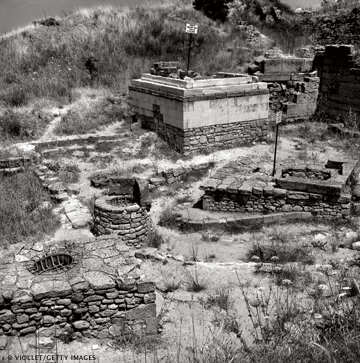
So much talk of war brings up yet another phase of Rose’s multifarious career. Few events have pained archaeologists more than the looting of the National Museum of Iraq in Baghdad after the American invasion in 2003, but Rose didn’t just sit around wringing his hands over the losses. “It seemed to me that archaeologists should offer their expertise,” he says, and on behalf of the Archaeological Institute of America he approached Marine Col. Matthew Bogdanos, who had been in the same grad-school program at Columbia with Rose (though they hadn’t known each other at the time). Bogdanos responded enthusiastically, and in 2004 Rose started teaching cultural heritage classes to officers and soldiers shipping out to Iraq and Afghanistan.
The lectures are apolitical—the idea is to help our men and women recognize historic sites and cultural artifacts and take action to protect them. Rose had envisioned a full-dress program involving several archaeologists and military bases, but for various reasons the effort has boiled down to him alone: about once a month, he makes the hour-long drive from Philadelphia to Fort Dix, New Jersey, where he gives a talk that lasts anywhere from one to three hours—a task he finds “incredibly rewarding.” To make the material more relevant to his audience, Rose hit upon the idea of citing Biblical events and personages associated with the region. “I therefore include such topics as archaeological evidence that has been linked to the flood account, the prophet Daniel, Abraham’s birthplace at Ur, and the Tower of Babel in Babylon.”
In 2008 Rose visited Iraq, where he blogged about what he saw and did. He had to wear body armor and a helmet whenever he left the base. But while flying over the countryside, he noticed “shepherds and … farmers frequently waving at the helicopter, and the gunners waving back. Scenes like this make one think that a corner has been turned.” About a visit to the Iraq Museum—now up and functioning again—Rose wrote: “A girls’ school group entered … as we were leaving, and it was good to hear the halls again filled with such enthusiasm.”
Activities such as digging up artifacts that may authenticate the Trojan War and touring war-torn Iraq by chopper make archaeology sound like one of the world’s coolest professions. Yet as Rose acknowledges, the nitty-gritty of excavating, classifying, and record-keeping can be tedious. “Part of the process is realizing that you aren’t going to find a statue every day,” he says. “You have to make a special effort to keep up the spirits of your staff. You try to adhere to your strategic plan, you visit each department of the excavation every single day, you express an interest in what they’re doing, and you stress how important it is to the work as a whole.
“Even if you’re disheartened yourself, you try not to let it show. There may come a day when you uncover so many artifacts that you can’t keep up with them, but there will also be days when you don’t find a thing. If you’re not a patient person, you shouldn’t be an archaeologist.”
Dennis Drabelle G’66 L’69 also has a book review in this issue.


